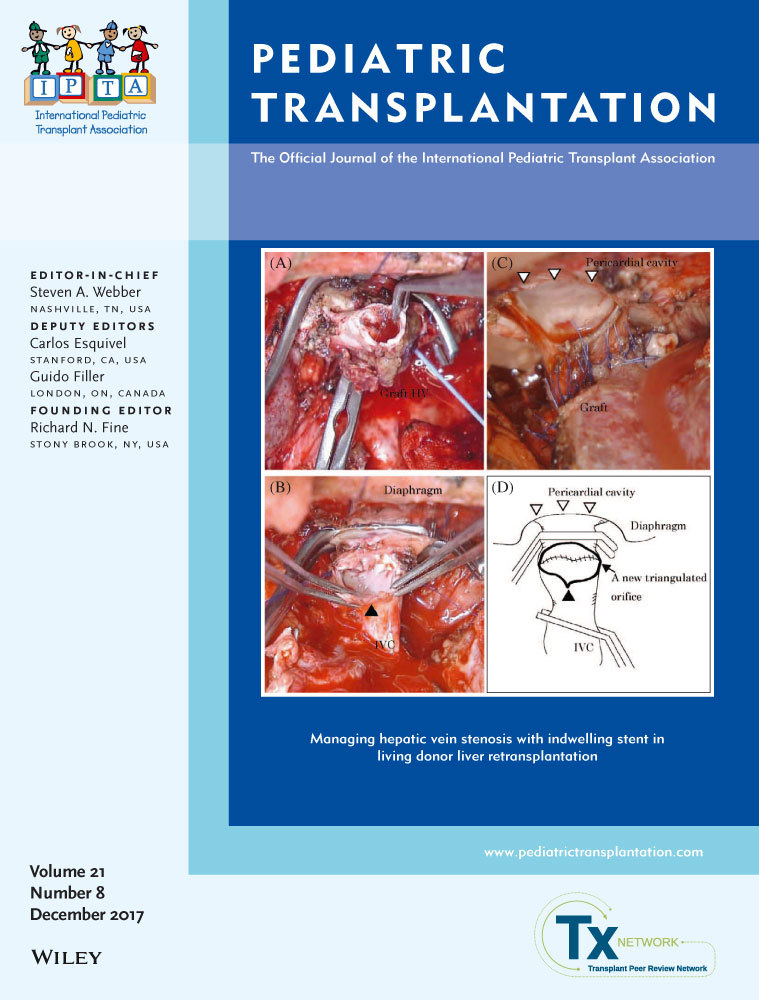Successful venoarterial extracorporeal membrane oxygenation for postoperative septic shock in a child with liver transplantation: A case report
Michiko Abe
Critical Care Medicine, National Center for Child Health and Development, Tokyo, Japan
Search for more papers by this authorCorresponding Author
Kentaro Ide
Critical Care Medicine, National Center for Child Health and Development, Tokyo, Japan
Correspondence
Kentaro Ide, National Center for Child Health and Development, Okura, Setagaya-ku, Tokyo, Japan.
Email: [email protected]
Search for more papers by this authorNao Nishimura
Critical Care Medicine, National Center for Child Health and Development, Tokyo, Japan
Search for more papers by this authorSatoshi Nakagawa
Critical Care Medicine, National Center for Child Health and Development, Tokyo, Japan
Search for more papers by this authorAkinari Fukuda
Organ Transplantation Center, National Center for Child Health and Development, Tokyo, Japan
Search for more papers by this authorSeisuke Sakamoto
Organ Transplantation Center, National Center for Child Health and Development, Tokyo, Japan
Search for more papers by this authorMureo Kasahara
Organ Transplantation Center, National Center for Child Health and Development, Tokyo, Japan
Search for more papers by this authorMichiko Abe
Critical Care Medicine, National Center for Child Health and Development, Tokyo, Japan
Search for more papers by this authorCorresponding Author
Kentaro Ide
Critical Care Medicine, National Center for Child Health and Development, Tokyo, Japan
Correspondence
Kentaro Ide, National Center for Child Health and Development, Okura, Setagaya-ku, Tokyo, Japan.
Email: [email protected]
Search for more papers by this authorNao Nishimura
Critical Care Medicine, National Center for Child Health and Development, Tokyo, Japan
Search for more papers by this authorSatoshi Nakagawa
Critical Care Medicine, National Center for Child Health and Development, Tokyo, Japan
Search for more papers by this authorAkinari Fukuda
Organ Transplantation Center, National Center for Child Health and Development, Tokyo, Japan
Search for more papers by this authorSeisuke Sakamoto
Organ Transplantation Center, National Center for Child Health and Development, Tokyo, Japan
Search for more papers by this authorMureo Kasahara
Organ Transplantation Center, National Center for Child Health and Development, Tokyo, Japan
Search for more papers by this authorAbstract
Refractory septic shock after LT is a life-threatening complication. VA ECMO is used to treat refractory cardiorespiratory failure. We present herein the case of a 5-year-old girl with post-Kasai biliary atresia, who underwent a living donor LT and suffered refractory septic shock. VA ECMO was indicated due to progressive cardiac deterioration. After full recovery of her EF, she has been steadily improving and has shown good liver function and no neurological sequelae. This is the first report of successful VA ECMO in a post- LT patient with refractory septic shock.
REFERENCES
- 1Kasahara M, Umeshita K, Inamata Y, Umemoto S. Long-term outcomes of pediatric living donor liver transplantation in Japan: an analysis of more than 2200 cases listed in the registry of the Japanese Liver Transplantation Society. Am J Transplant. 2013; 13: 1830-1839.
- 2Spada M, Riva S, Maggiore G, Cintorino D, Gridelli B. Pediatric liver transplantation. World J Gastroenterol. 2009; 15: 648-674.
- 3Rehder KJ, Turner DA, Cheifetz IM. Extracorporeal membrane oxygenation for neonatal and pediatric respiratory failure: an evidence-based review of the past decade (2002-2012). Pediatr Crit Care Med. 2013; 14: 851-861.
- 4Maclaren G, Butt W, Best D, Donath S, Taylor A. Extracorporeal membrane oxygenation for refractory septic shock in children: one institution's experience. Pediatr Crit Care Med. 2007; 8: 447-451.
- 5Custer JR. The evolution of patient selection criteria and indications for extracorporeal life support in pediatric cardiopulmonary failure: next time, let's not eat the bones. Organogenesis. 2011; 7: 13-22.
- 6Mack CL, Millis JM, Whitington PF, Alonso EM. Pulmonary complications following liver transplantation in pediatric patients. Pediatr Transplant. 2000; 4: 39-44.
- 7Fujita S, Hemming AW, Fujikawa T, et al. Expanded efficacy and indication of extracorporeal membrane oxygenation for preoperative pulmonary bleeding on pediatric cadaveric orthotopic liver transplantation. Transplantation. 2005; 79: 1637.
- 8Fleming GM, Cornell TT, Welling TH, Magee JC, Annich GM. Hepatopulmonary syndrome: use of extracorporeal life support for life-threatening hypoxia following liver transplantation. Liver Transpl. 2008; 14: 966-970.
- 9Landsman IS, Karsanac CJ. Case report: pediatric liver retransplantation on an extracorporeal membrane oxygenation-dependent child. Anesth Analg. 2010; 111: 1275-1278.
- 10Son SK, Oh SH, Kim KM, et al. Successful liver transplantation following veno-arterial extracorporeal membrane oxygenation in a child with fulminant Wilson disease and severe pulmonary hemorrhage: a case report. Pediatr Transplant. 2012; 16: E281-E285.
- 11Chan-Dominy AC, Rahiman SN, Anders M, Butt W. Extracorporeal membrane oxygenation and severe portopulmonary hypertension following liver transplantation: brief report. Int J Artif Organs. 2015; 38: 337-342.
- 12Nandhabalan P, Loveridge R, Patel S, et al. Extracorporeal membrane oxygenation and pediatric liver transplantation, “a step too far?”: results of a single-center experience. Liver Transpl. 2016; 22: 1727-1733.
- 13Dellinger RP, Levy MM, Rhodes A, et al. Surviving sepsis campaign: international guidelines for management of severe sepsis and septic shock: 2012. Crit Care Med. 2013; 41: 580-637.
- 14Fliman PJ, deRegnier RA, Kinsella JP, Reynolds M, Rankin LL, Steinhorn RH. Neonatal extracorporeal life support: impact of new therapies on survival. J Pediatr. 2006; 148: 595-599.
- 15Zabrocki LA, Brogan TV, Statler KD, Poss WB, Rollins MD, Bratton SL. Extracorporeal membrane oxygenation for pediatric respiratory failure: survival and predictors of mortality. Crit Care Med. 2011; 39: 364-370.
- 16Skinner SC, Iocono JA, Ballard HO, et al. Improved survival in venovenous vs venoarterial extracorporeal membrane oxygenation for pediatric noncardiac sepsis patients: a study of the Extracorporeal Life Support Organization registry. J Pediatr Surg. 2012; 47: 63-67.
- 17Burch M, Aurora P. Current status of paediatric heart, lung, and heart-lung transplantation. Arch Dis Child. 2004; 89: 386-389.
- 18Oto T, Rosenfeldt F, Rowland M, et al. Extracorporeal membrane oxygenation after lung transplantation: evolving technique improves outcomes. Ann Thorac Surg. 2004; 78: 1230-1235.
- 19Gupta M, Shanley TP, Moler FW. Extracorporeal life support for severe respiratory failure in children with immune compromised conditions. Pediatr Crit Care Med. 2008; 9: 380-385.
- 20Romero-Bermejo FJ, Ruiz-Bailen M, Gil-Cebrian J, Huertos-Ranchal MJ. Sepsis-induced cardiomyopathy. Curr Cardiol Rev. 2011; 7: 163-183.




